Matrix-Assisted DOSY for Analysis of Indole Alkaloid Mixtures
Abstract
1. Introduction
2. Results and Discussion
2.1. Evaluation of Different Matrices to Separate Indole Alkaloid Mixtures
2.2. Optimization of DOSY Experimental Conditions
2.3. Investigation of the Influence Factors on the Separation Performance
2.3.1. Influence of SDS Concentration
2.3.2. Influence of Solvent Polarity
2.4. The Application of SDS-Assisted DOSY in Separation of Total Alkaloid Extract
3. Materials and Methods
3.1. Ragents and Materials
3.2. Instrumentation
3.3. NMR Experiments
4. Conclusions
Supplementary Materials
Author Contributions
Funding
Institutional Review Board Statement
Informed Consent Statement
Data Availability Statement
Conflicts of Interest
Sample Availability
References
- Schmid, R.; Bruneton, J.; Hatton, C.K. Pharmacognosy, Phytochemistry, Medicinal Plants. TAXON 1995, 44, 469. [Google Scholar] [CrossRef]
- Qin, N.; Lu, X.; Liu, Y.; Qiao, Y.; Qu, W.; Feng, F.; Sun, H. Recent research progress of Uncaria spp. based on alkaloids: Phytochemistry, pharmacology and structural chemistry. Eur. J. Med. Chem. 2021, 210, 112960. [Google Scholar] [CrossRef] [PubMed]
- Singh, T.P.; Singh, O.M. Recent Progress in Biological Activities of Indole and Indole Alkaloids. Mini-Rev. Med. Chem. 2017, 18, 9–25. [Google Scholar] [CrossRef]
- Sravanthi, T.; Manju, S. Indoles A promising scaffold for drug development. Eur. J. Pharm. Sci. 2016, 91, 1–10. [Google Scholar] [CrossRef] [PubMed]
- Gul, W.; Hamann, M.T. Indole alkaloid marine natural products: An established source of cancer drug leads with considerable promise for the control of parasitic, neurological and other diseases. Life Sci. 2005, 78, 442–453. [Google Scholar] [CrossRef] [PubMed]
- Mekky, H.; Al-Sabahi, J.; Abdel-Kreem, M. Potentiating biosynthesis of the anticancer alkaloids vincristine and vinblastine in callus cultures of Catharanthus roseus. S. Afr. J. Bot. 2018, 114, 29–31. [Google Scholar] [CrossRef]
- Isaac, M.T. Review: Combining pindolol with an SSRI improves early outcomes in people with depression. Évid. Based Ment. Health 2004, 7, 107. [Google Scholar] [CrossRef] [PubMed]
- Zhang, Q.; Zhao, J.J.; Xu, J.; Feng, F.; Qu, W. Medicinal uses, phytochemistry and pharmacology of the genus Uncaria. J. Ethnopharmacol. 2015, 173, 48–80. [Google Scholar] [CrossRef] [PubMed]
- Li, C.M.; Su, J.; Mu, Q.; Zheng, H.L.; Wu, S.G. Indole Alkaloids from Roots of Alstonia mairei. Acta Bot. Yunnan. 1998, 20, 244–246. [Google Scholar]
- Cai, X.-H.; Zeng, C.-X.; Feng, T.; Li, Y.; Luo, X.-D. Monoterpenoid Indole Alkaloids from Alstonia mairei. Helvetica Chim. Acta 2010, 93, 2037–2044. [Google Scholar] [CrossRef]
- Li, P.T.; Antony, J.M.L.; David, J.M. Flora of China; Science Press: Beijing, China, 1995; pp. 143–188. [Google Scholar]
- Kumar, S.; Singh, A.; Kumar, B. Screening of monoterpene indole alkaloids in six Rauwolfia species by ultra-high performance liquid chromatography orbitrap velos pro mass spectrometer. Sep. Sci. PLUS 2019, 2, 300–308. [Google Scholar] [CrossRef]
- Kumar, S.; Singh, A.; Kumar, B.; Singh, B.; Bahadur, L.; Lal, M. Simultaneous quantitative determination of bioactive terpene indole alkaloids in ethanolic extracts of Catharanthus roseus (L.) G. Don by ultra high performance liquid chromatography–tandem mass spectrometry. J. Pharm. Biomed. Anal. 2018, 151, 32–41. [Google Scholar] [CrossRef] [PubMed]
- Viel, S.; Ziarelli, F.; Caldarelli, S. Enhanced diffusion-edited NMR spectroscopy of mixtures using chromatographic stationary phases. Proc. Natl. Acad. Sci. USA 2003, 100, 9696–9698. [Google Scholar] [CrossRef] [PubMed]
- Morris, K.F.; Johnson, C.S., Jr. Diffusion-ordered two-dimensional nuclear magnetic resonance spectroscopy. J. Am. Chem. Soc. 1992, 114, 3139–3141. [Google Scholar] [CrossRef]
- Johnson, C. Diffusion ordered nuclear magnetic resonance spectroscopy: Principles and applications. Prog. Nucl. Magn. Reson. Spectrosc. 1999, 34, 203–256. [Google Scholar] [CrossRef]
- Novoa-Carballal, R.; Fernandez-Megia, E.; Jiménez, C.; Riguera, R. NMR methods for unravelling the spectra of complex mixtures. Nat. Prod. Rep. 2011, 28, 78–98. [Google Scholar] [CrossRef] [PubMed]
- Jerschow, A.; Müller, N. Diffusion-Separated Nuclear Magnetic Resonance Spectroscopy of Polymer Mixtures. Macromology 1998, 31, 6573–6578. [Google Scholar] [CrossRef]
- Durand, E.; Clemancey, M.; Quoineaud, A.-A.; Verstraete, J.; Espinat, D.; Lancelin, J.-M. 1H Diffusion-Ordered Spectroscopy (DOSY) Nuclear Magnetic Resonance (NMR) as a Powerful Tool for the Analysis of Hydrocarbon Mixtures and Asphaltenes. Energy Fuels 2008, 22, 2604–2610. [Google Scholar] [CrossRef]
- Li, D.; Keresztes, I.; Hopson, R.; Williard, P.G. ChemInform Abstract: Characterization of Reactive Intermediates by Multinuclear Diffusion-Ordered NMR Spectroscopy (DOSY). Acc. Chem. Res. 2009, 40, 270–280. [Google Scholar] [CrossRef] [PubMed]
- Wu, M.; Wu, Z.; Ding, S.; Chen, Z.; Cui, X. Different submicellar solubilization mechanisms revealed by 1H NMR and 2D diffusion ordered spectroscopy (DOSY). Phys. Chem. Chem. Phys. 2020, 22, 11075–11085. [Google Scholar] [CrossRef]
- Salome, K.S.; Tormena, C.F. Enantiodiscrimination by matrix-assisted DOSY NMR. Chem. Commun. 2019, 55, 8611–8614. [Google Scholar] [CrossRef] [PubMed]
- Kandiyal, P.S.; Kim, J.Y.; Fortunati, D.L.; Mok, K.H. Size Determination of Protein Oligomers/Aggregates Using Diffusion NMR Spectroscopy. In Topics in Safety, Risk, Reliability and Quality; Apress: New York, NY, USA, 2019; Volume 2039, pp. 173–183. [Google Scholar]
- Viel, S.; Capitani, D.; Mannina, L.; Segre, A. Diffusion-Ordered NMR Spectroscopy: A Versatile Tool for the Molecular Weight Determination of Uncharged Polysaccharides. Biomacromolecules 2003, 4, 1843–1847. [Google Scholar] [CrossRef] [PubMed]
- Concepts and Principles of High Performance Liquid Chromatography. In Methods of Biochemical Analysis; Wiley: Hoboken, NJ, USA, 2006; pp. 13–40.
- Malviya, R.; Bansal, V.; Pal, O.P.; Sharma, P.K. High performance liquid chromatography: A short review. J. Glob. Pharma Technol. 2010, 2, 22–26. [Google Scholar] [CrossRef]
- Day, I.J. Matrix-assisted DOSY. Prog. Nucl. Magn. Reson. Spectrosc. 2020, 116, 1–18. [Google Scholar] [CrossRef]
- Hoffman, R.E.; Arzuan, H.; Pemberton, C.; Aserin, A.; Garti, N. High-resolution NMR “chromatography” using a liquids spectrometer. J. Magn. Reson. 2008, 194, 295–299. [Google Scholar] [CrossRef] [PubMed]
- Yang, Y.; Wu, R.; Huang, S.; Bai, Z. Silica sol assisted chromatographic NMR spectroscopy for resolution of trans- and cis-isomers. J. Magn. Reson. 2016, 265, 210–214. [Google Scholar] [CrossRef] [PubMed]
- Evans, R.; Haiber, S.; Nilsson, M.; Morris, G.A. Isomer Resolution by Micelle-Assisted Diffusion-Ordered Spectroscopy. Anal. Chem. 2009, 81, 4548–4550. [Google Scholar] [CrossRef]
- Tormena, C.F.; Evans, R.; Haiber, S.; Nilsson, M.; Morris, G.A. Matrix-assisted diffusion-ordered spectroscopy: Application of surfactant solutions to the resolution of isomer spectra. Magn. Reson. Chem. 2012, 50, 458–465. [Google Scholar] [CrossRef] [PubMed]
- Kavakka, J.S.; Kilpeläinen, I.; Heikkinen, S. General Chromatographic NMR Method in Liquid State for Synthetic Chemistry: Polyvinylpyrrolidone Assisted DOSY Experiments. Org. Lett. 2009, 11, 1349–1352. [Google Scholar] [CrossRef] [PubMed]
- Huang, S.; Gao, J.; Wu, R.; Li, S.; Bai, Z. Polydimethylsiloxane: A General Matrix for High-Performance Chromatographic NMR Spectroscopy. Angew. Chem. 2014, 126, 11776–11779. [Google Scholar] [CrossRef]
- Zielinski, M.E.; Morris, K.F. Using perdeuterated surfactant micelles to resolve mixture components in diffusion-ordered NMR spectroscopy. Magn. Reson. Chem. 2009, 47, 53–56. [Google Scholar] [CrossRef] [PubMed]
- Bednarek, E.; Sitkowski, J.; Bocian, W.; Mulloy, B.; Kozerski, L. An Assessment of Polydispersed Species in Unfractionated and Low Molecular Weight Heparins by Diffusion Ordered Nuclear Magnetic Resonance Spectroscopy Method. J. Pharm. Biomed. Anal. 2010, 53, 302–308. [Google Scholar] [CrossRef] [PubMed]
- Antalek, B. Using Pulsed Gradient Spin Echo NMR for Chemical Mixture Analysis: How to Obtain Optimum Results. Concepts Magn. Reson. 2010, 14, 225–258. [Google Scholar] [CrossRef]
- Chen, X.; Hu, R.; Feng, H.; Chen, L.; Lüdemann, H.-D. Intradiffusion, Density, and Viscosity Studies in Binary Liquid Systems of Acetylacetone + Alkanols at 303.15 K. J. Chem. Eng. Data 2012, 57, 2401–2408. [Google Scholar] [CrossRef]
- Huang, S.; Wu, R.; Bai, Z.; Yang, Y.; Li, S.; Dou, X. Evaluation of the separation performance of polyvinylpyrrolidone as a virtual stationary phase for chromatographic NMR. Magn. Reson. Chem. 2014, 52, 486–490. [Google Scholar] [CrossRef] [PubMed]
- Loening, N.M.; Keeler, J. Measurement of Convection and Temperature Profiles in Liquid Samples. J. Magn. Reson. 1999, 139, 334–341. [Google Scholar] [CrossRef] [PubMed]
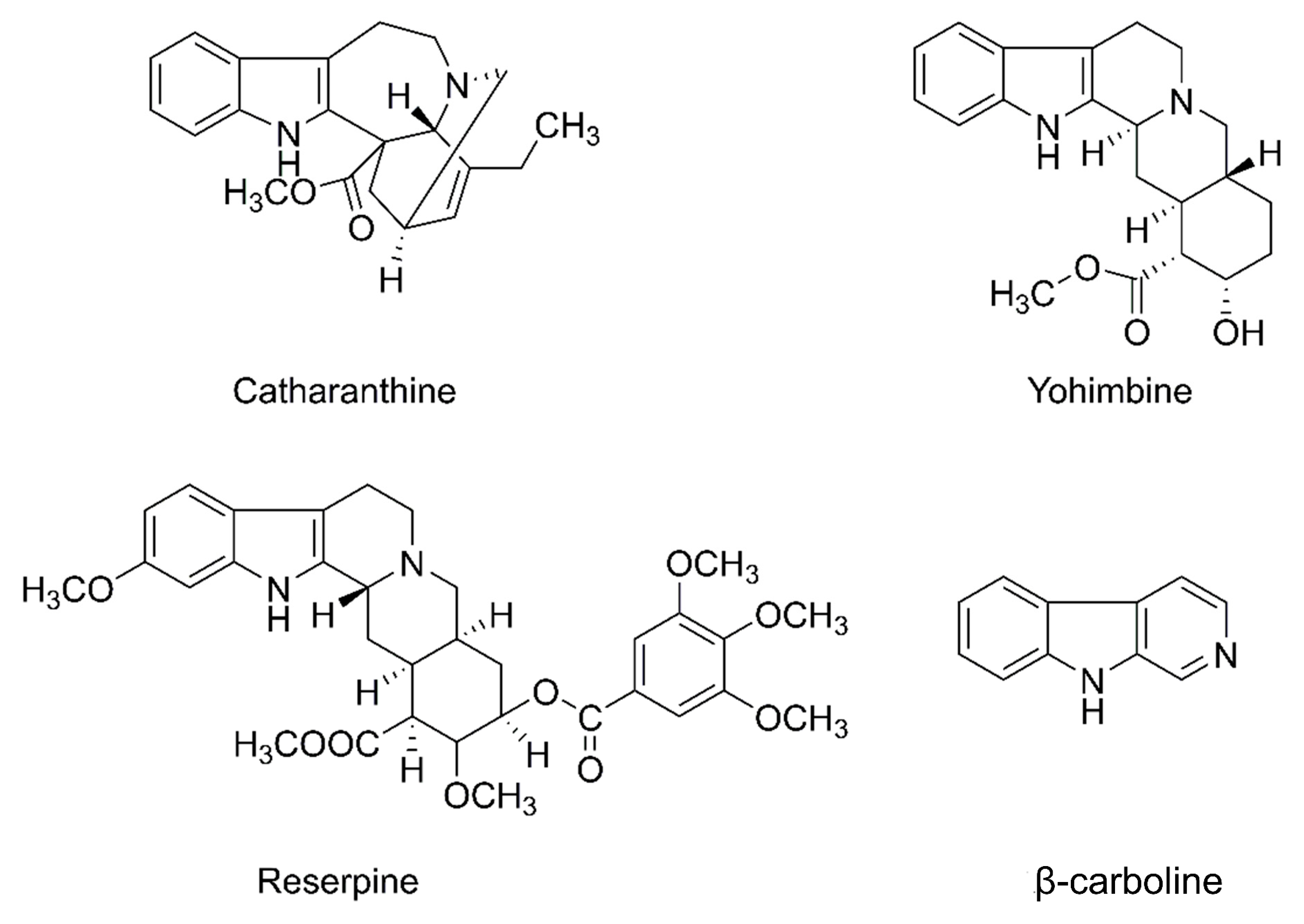
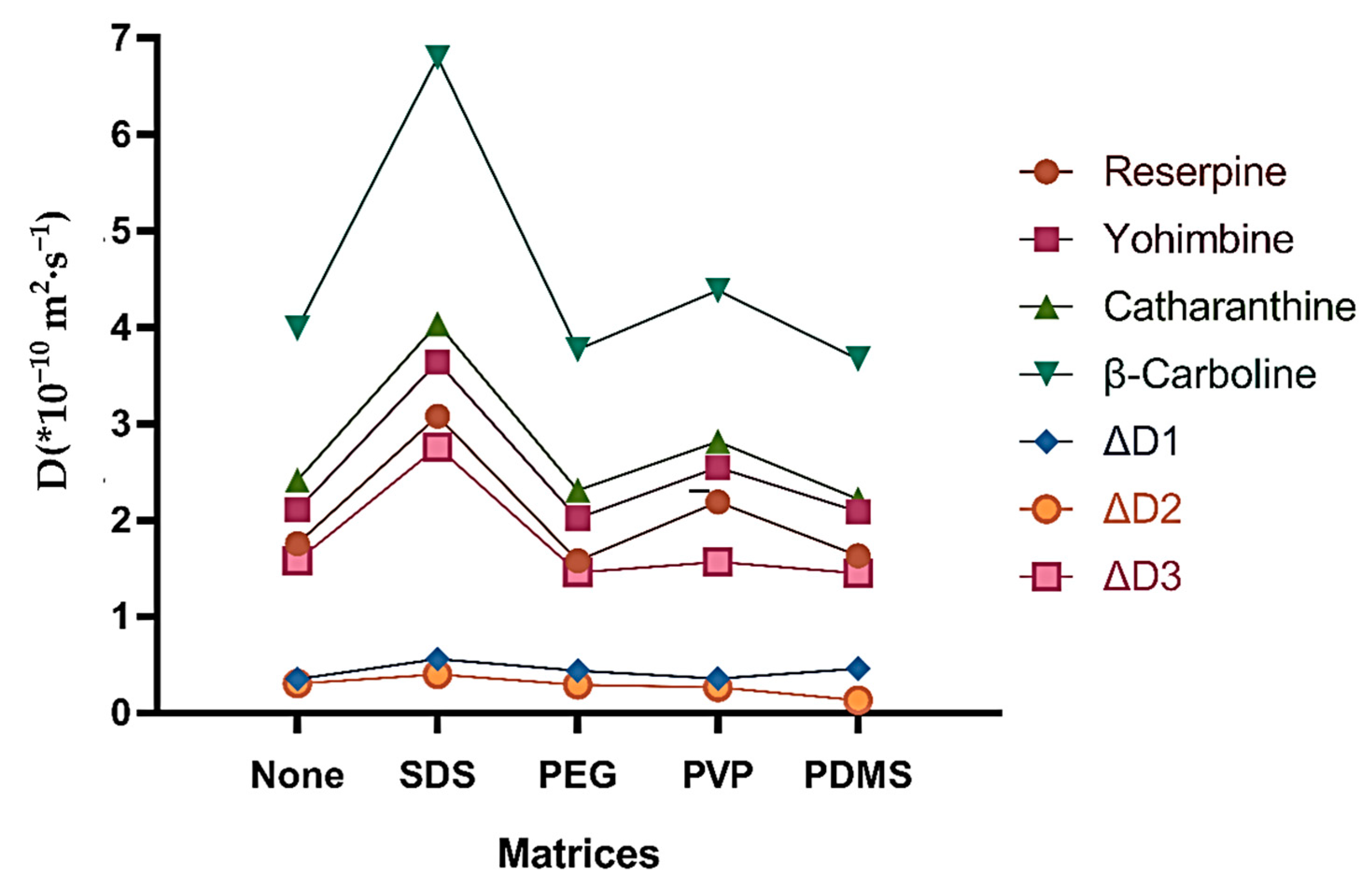
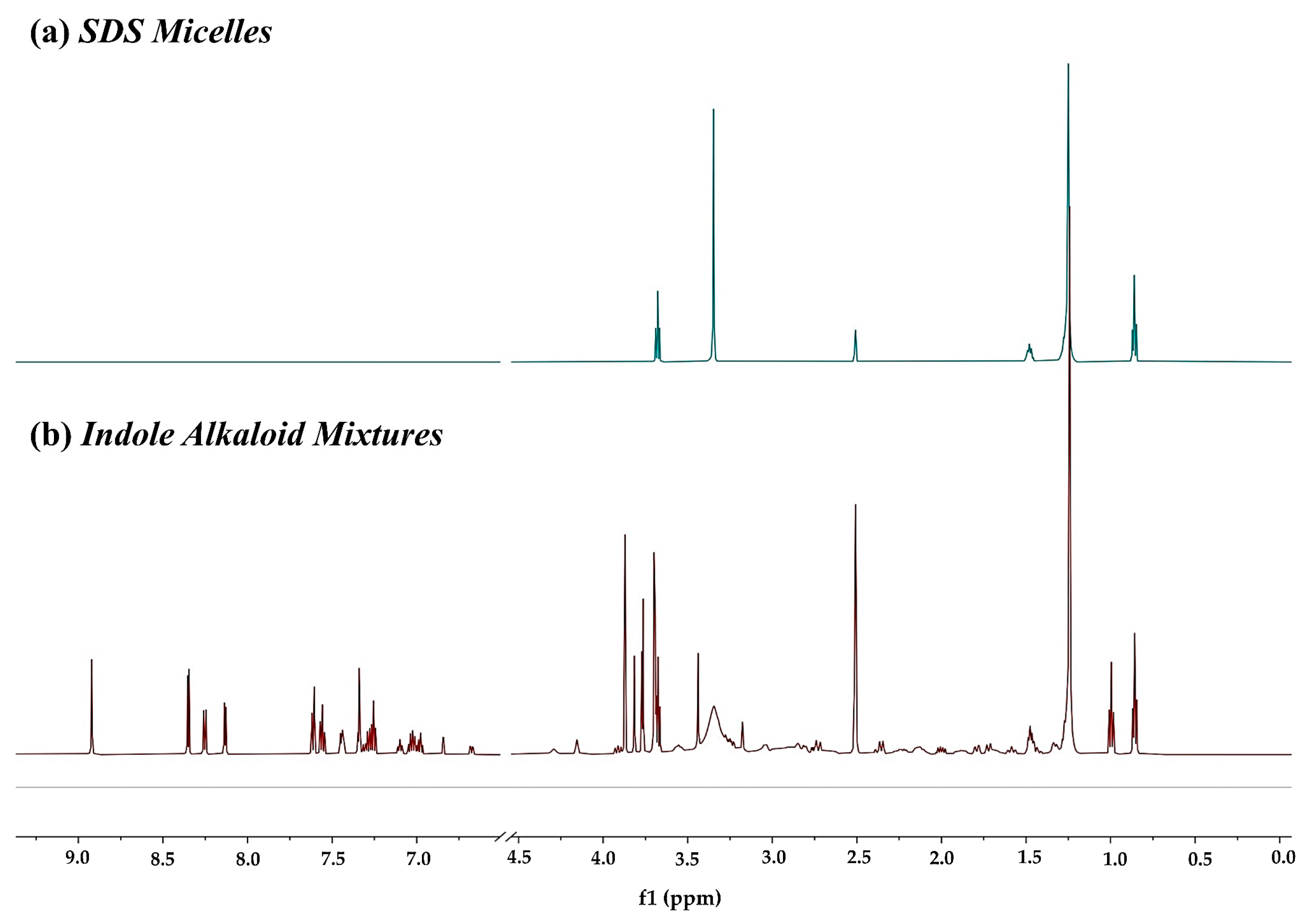

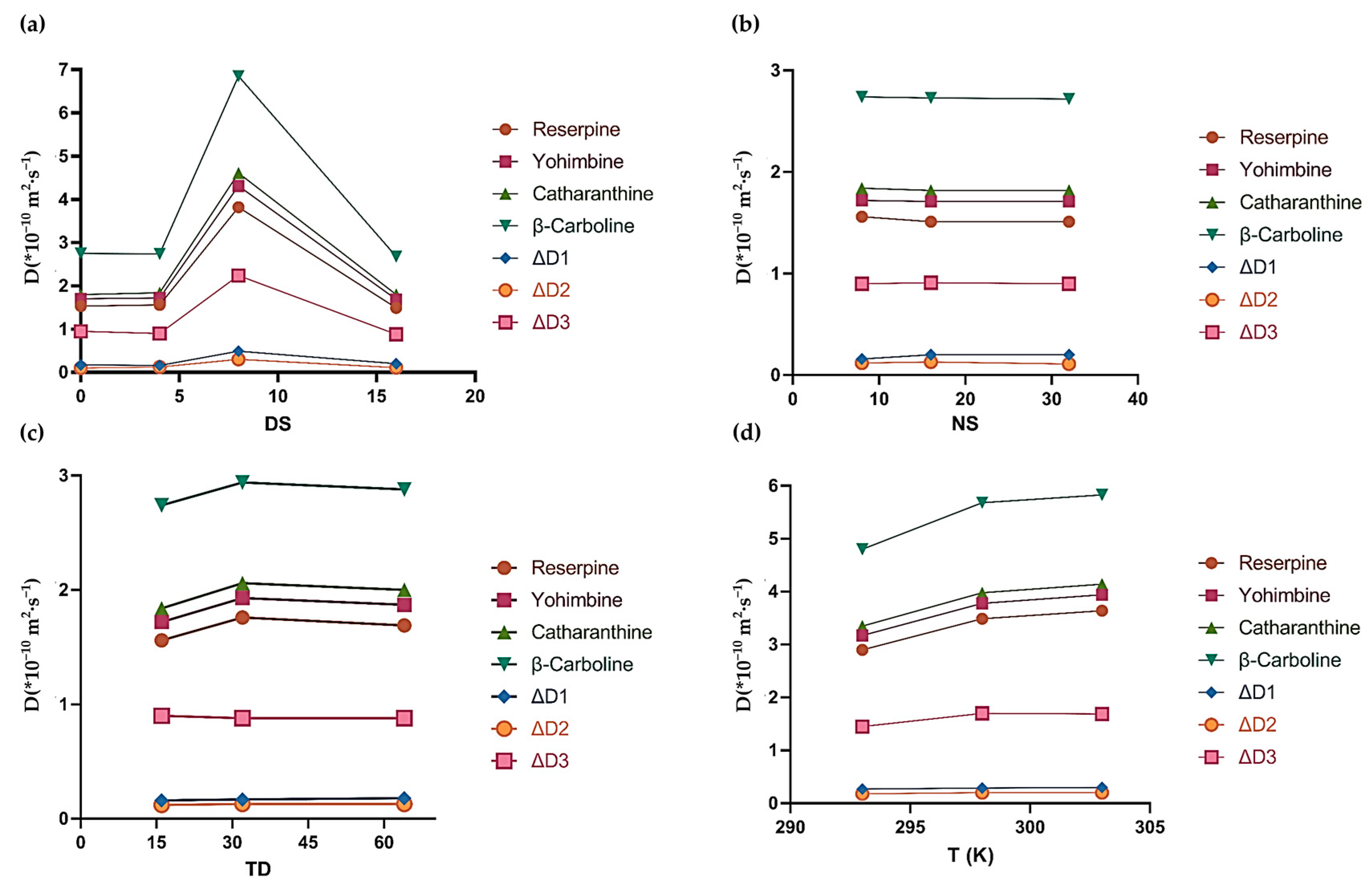
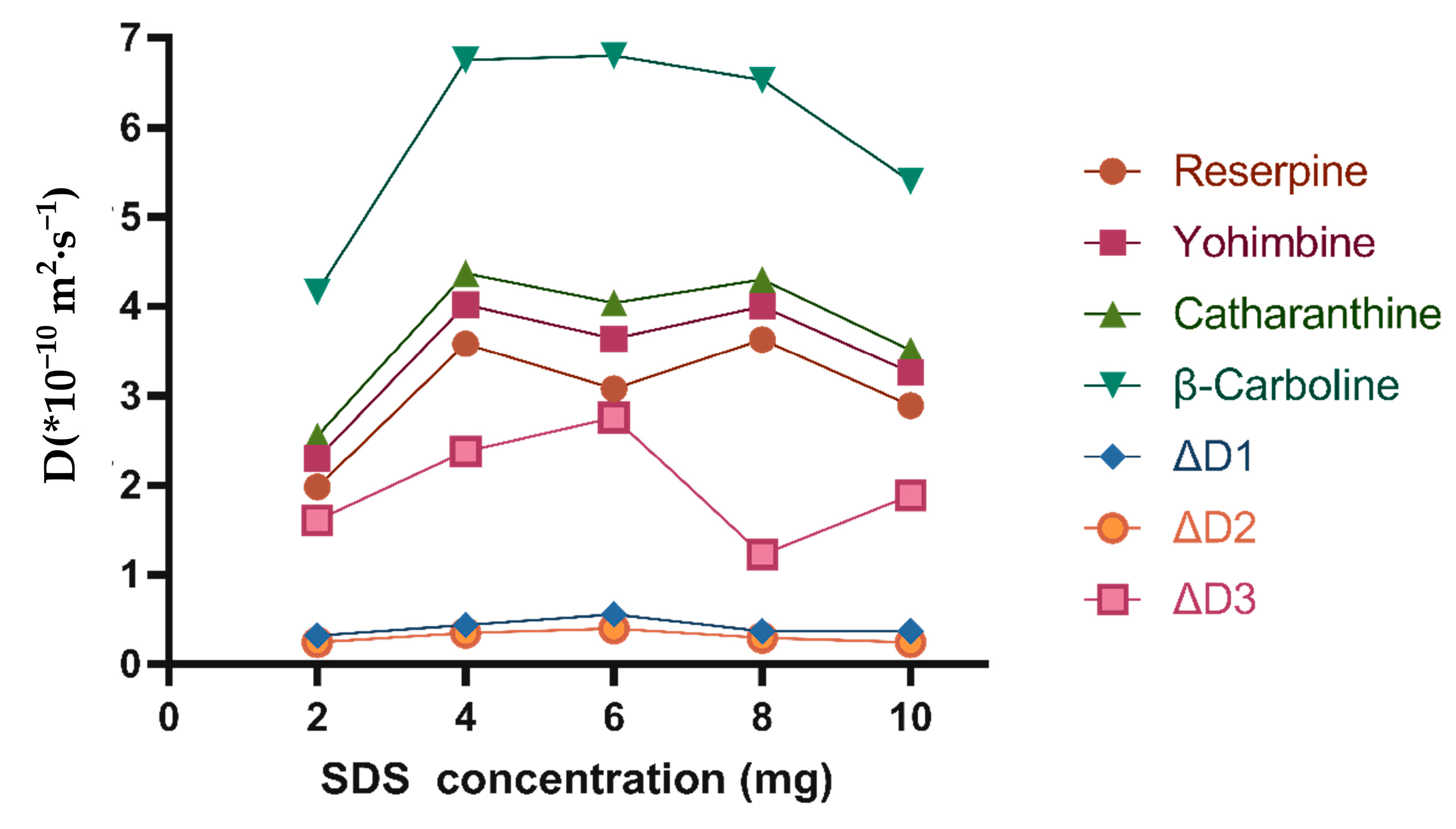
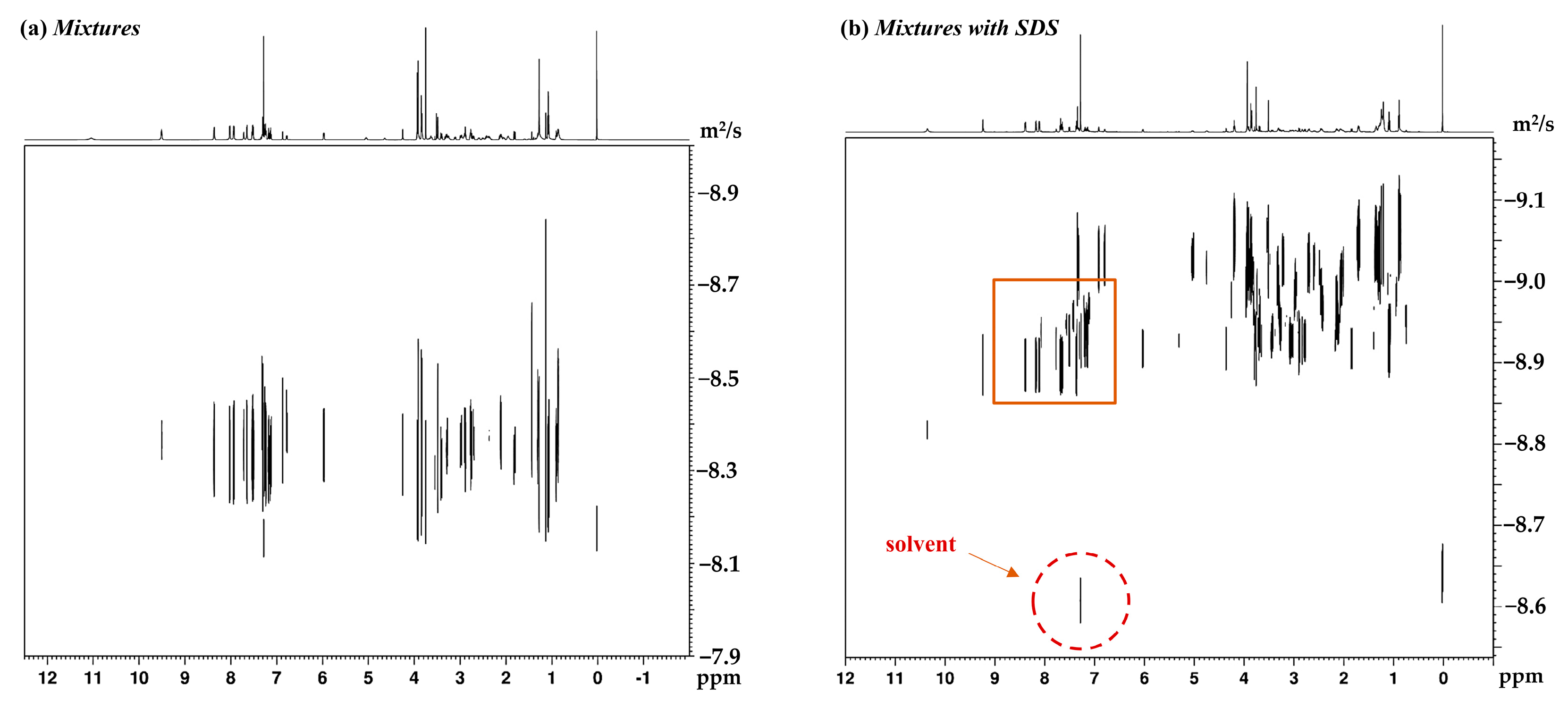
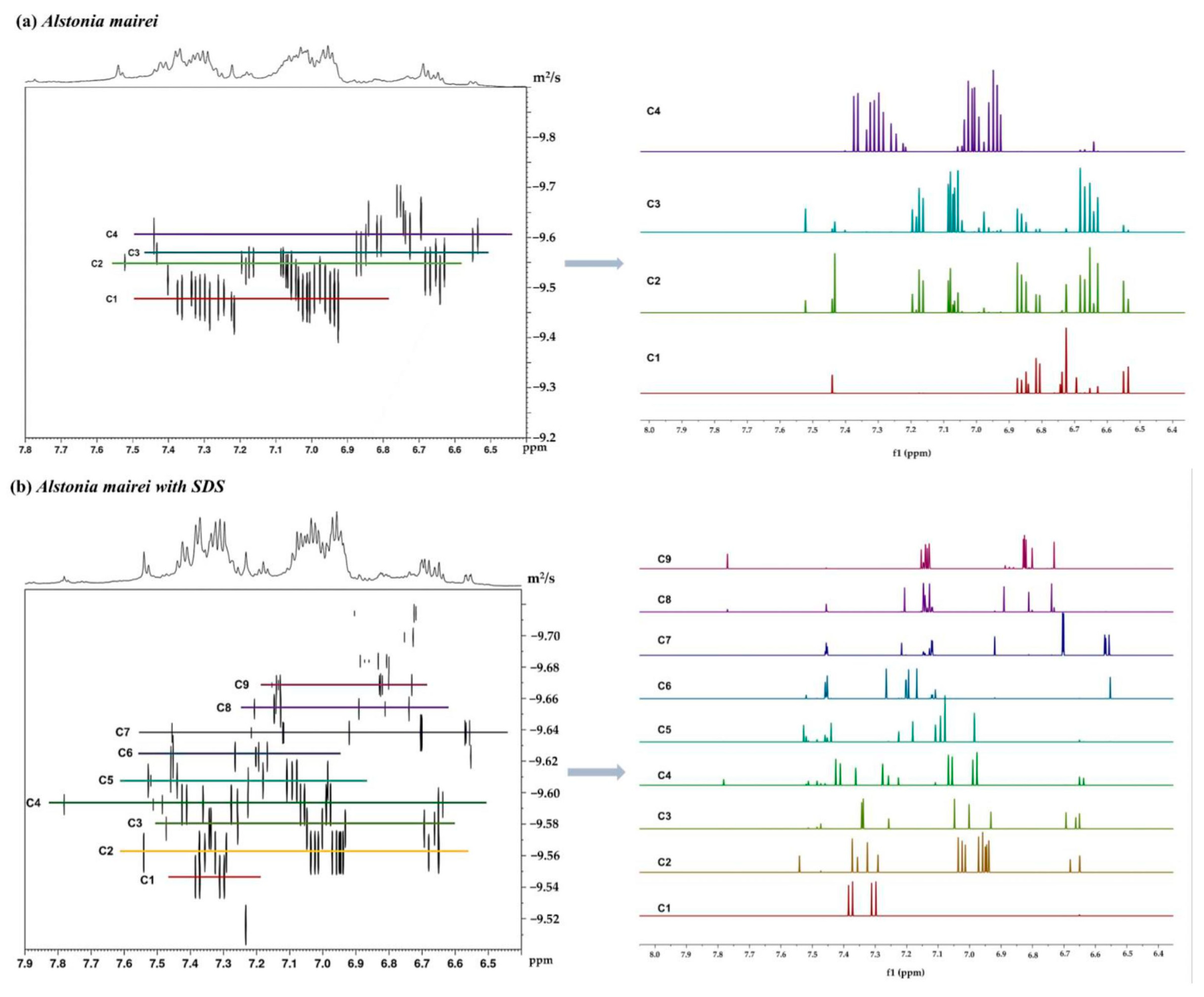
| No. | Parameters | Values |
|---|---|---|
| 1 | Number of dummy scans | 0, 4, 8, 16 a |
| 2 | Number of scans | 8, 16, 32 |
| 3 | The FID data points | 16, 32, 64 |
| 4 | Experimental temperature (K) | 293, 298, 303 |
Publisher’s Note: MDPI stays neutral with regard to jurisdictional claims in published maps and institutional affiliations. |
© 2021 by the authors. Licensee MDPI, Basel, Switzerland. This article is an open access article distributed under the terms and conditions of the Creative Commons Attribution (CC BY) license (http://creativecommons.org/licenses/by/4.0/).
Share and Cite
You, Y.-L.; Li, F.-F.; Wang, N.; Wang, S.-Q. Matrix-Assisted DOSY for Analysis of Indole Alkaloid Mixtures. Molecules 2021, 26, 1751. https://doi.org/10.3390/molecules26061751
You Y-L, Li F-F, Wang N, Wang S-Q. Matrix-Assisted DOSY for Analysis of Indole Alkaloid Mixtures. Molecules. 2021; 26(6):1751. https://doi.org/10.3390/molecules26061751
Chicago/Turabian StyleYou, Yu-Lin, Fei-Fei Li, Ning Wang, and Shu-Qi Wang. 2021. "Matrix-Assisted DOSY for Analysis of Indole Alkaloid Mixtures" Molecules 26, no. 6: 1751. https://doi.org/10.3390/molecules26061751
APA StyleYou, Y.-L., Li, F.-F., Wang, N., & Wang, S.-Q. (2021). Matrix-Assisted DOSY for Analysis of Indole Alkaloid Mixtures. Molecules, 26(6), 1751. https://doi.org/10.3390/molecules26061751







